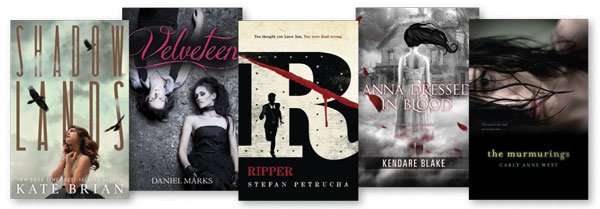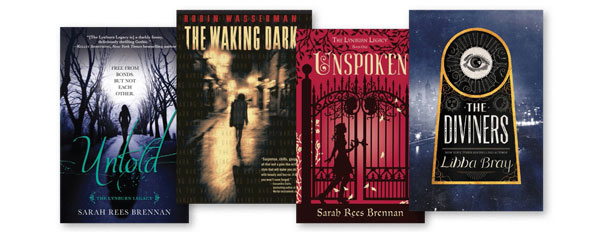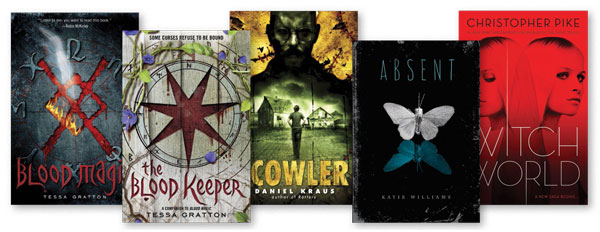Horror in YA Lit is a Staple, Not a Trend

Though R. L. Stine and Christopher Pike may be our quickest associations with teen screams, horror encompasses a wide array of books. As Susan Chang, senior editor of the children’s and young adult division at Tom Doherty Associates (Tor), says, “I think what we define as ‘horror’ has changed since the heyday of the 1980s and 1990s. Boundaries are more blurred and fluid and so it is more difficult to define.” At the Horror Writers Association site, author Jonathan Maberry has developed a YA-specific blog, It’s Scary Out There, to show how horror isn’t just one type of story.
Maberry explains, “The blog is built around exploring the nature of horror and of fear, how that’s different for teens and adults, and why so many of today’s writers tackle that subject matter. The answers are always surprising. What we’re showing is that horror is different for each person.”
The blog offers interviews with authors Kendare Blake, Darren Shan, Barry Lyga, and Holly Black, with more to come.

Categorizing horror
What is horror if the boundaries are difficult to define? It’s any work where the emotions of fear, dread, and/or disgust drive the narrative. Readers either love or hate horror because it forces them to experience reading in a visceral way. Because it’s defined by how individual readers interpret a story, what one sees as horror may not resonate that way to another.
Horror isn’t comprised solely of monsters. It also consists of the everyday darkness YA readers experience. “Horror isn’t always necessarily supernatural,” Maberry notes. “[In a forthcoming blog interview] Ellen Hopkins will discuss peer pressure as horror.” Dark realistic fiction, serial killer stories, and psychological thrillers may not be “traditional” horror, but they can elicit equally strong responses of fear or dread.
Chang suggests that the decline of mass market publishing, common in the 1980s and 1990s, means readers see horror in a new way. “With the change in format to hardcover and trade paperback, horror now seems to be considered more ‘literary’ and ‘upscale,’ and perhaps taken more seriously.”
Defining the horror reader can be challenging. As Brian Farrey-Lutz, acquisitions editor at Flux, says, “I think the true horror fans can be hard to pin down. There are definitely hardcore horror fans who can’t get enough of it. But I think the people who enjoy horror occasionally and don’t seek it out on a regular basis are a larger group.”
Is there a horror trend?
Maybe because we’ve become used to trends and “the next big thing” in YA, we can overlook staples like horror that don’t fall neatly into one genre. Yet, it continues to command shelf space and endear readers.
“If we’re seeing a spike in horror, it’s because there’s a need for something different,” says Farrey-Lutz. “I think horror is sticking its toes in the YA waters to test the temperature and see if there’s enough interest to merit a wave.”
The surge of dystopian and postapocalyptic YA novels in recent years taps directly into the interest in horror, Mayberry says. “[Teens] don’t read it to indulge in downbeat nihilism. Rather the reverse. My generation thought we were going to fix the world and solve all of society’s problems. We tried, we did some good, but let’s face it: the world is a mess. We may have lost some of our optimism about the future, but the teens expect to live in the future. They’re taking the broken fall and they’re going to fix it and run with it.”
Horror captures the attention of teens of all reading abilities–advanced and reluctant readers find it compelling because it’s something to which they relate. Sure, they may not be fighting zombies or ending decades-long curses, but those stories serve as metaphors for the challenges they face every day. In many ways, the ability to slip into fictional horrors offers an escape from their own sometimes-scary realities.
Ripper tales and serial killers
Perhaps due in part to TV shows like Dexter—which stars a Miami Police Department employee who moonlights as a serial killer—there’s been a rise in stories about murder. Starting with The Name of the Star (Putnam, 2012), Maureen Johnson’s “Shades of London” trilogy follows Rory at her boarding school in modern-day London, where a rash of killings echoing those of Jack the Ripper throws everyone into panic.
Stefan Petrucha’s Ripper (Philomel, 2012) is set in New York City, 1895, during a series of Ripper-like murders. When the Pinkerton Agency gives 14-year-old Carver an apprenticeship, the cases multiply. Does Carver have a tie to the killer?
How about having a dad who kills for a living? That’s 17-year-old Jazz’s story in Barry Lyga’s trilogy, which begins with I Hunt Killers (Little, Brown, 2012). Jazz helps police hunt for a new killer in town in an effort to keep his own name clear.
Peter Adam Salomon’s Henry Franks (Flux, 2012)—a modernization of Mary Shelley’s Frankenstein—begins when Henry questions the accident that took his mother’s life. Things become stranger when a serial killer emerges in town.
In Kate Brian’s Shadowlands (2012), even the Witness Protection Program can’t shield Rory Miller from a serial killer. In her old hometown, she barely escaped the hand of Steven Nell, and her new town may not be a safe haven, either. The story continues in Hereafter (2013, both Hyperion).
If murder wasn’t complicated enough, it becomes even murkier in two novels that explore the land between the living and the dead. Daniel Marks’s Velveteen (Delacorte, 2012) follows a 16-year-old slain by a serial killer named Bonesaw. Rather than landing in a happy afterlife, Velveteen’s stuck in a space more like purgatory. In Brenna Yovanoff’s Paper Valentine (Penguin, 2013), all Hannah wants to do is grieve best friend Lillian’s death. But then Lillian’s ghost begs Hannah to investigate a string of teen-girl murders in their small town.
Of sanity and spirits
Psychological horror leaves one question in the minds of both characters and readers: Was what happened real, or the work of something supernatural? At times it’s plausible (and even obvious) that there’s a ghost in charge; at others, it’s possible the horror may be internally constructed.
There’s not a question about the existence of ghosts in Kendare Blake’s Anna Dressed in Blood (2011) and Girl of Nightmares (2012, both Tor). Cas hunts and kills ghosts. When the teen comes upon a ghost who has vanquished every hunter who dared set sights on her, Cas discovers that she has chosen to spare him.
Spirits and sanity rub against one another quite literally in Carly Anne West’s The Murmurings (S & S, 2013). Sophie’s sister, Nell, was institutionalized for hearing voices—the same voices Sophie finds herself hearing now. As she investigates further, she learns that there just might be something out to get them.
Nova Ren Suma delves into what it means to be haunted in two stirring novels. In Imaginary Girls (2011), Chloe admires her big sister, Ruby, who is beautiful and mysterious. But when a classmate’s body shows up in the reservoir, Chloe questions what parts of her relationship with Ruby are imagined. 17 & Gone (2013, both Dutton) is an even sharper exploration of madness. Lauren sees girls who have gone missing, and what ties them together is their age when they disappeared. But who are they to her? As her 17th birthday inches closer, Lauren worries she’s destined to disappear, too. Think Shirley Jackson, YA style.

The undead
What’s more horrifying than the thought of the dead rising and coming after those still alive? Maybe having to face undead loved ones and deliver the final blow. Chang notes that while the zombie trend may be over—having hit its peak between 2007 and 2009—it has become more “evergreen,” much like vampires. Maberry agrees, “They’re tidal. They may recede from popularity for a while but they always come back.” Zombies have also been kept fresh and fascinating in the media, with TV’s The Walking Dead and the recent film Warm Bodies.
Sloane Price is determined to kill herself, thanks to an abusive home life and a sister who abandoned her, but things fall apart with the appearance of the undead in Courtney Summers’s This Is Not a Test (St. Martin’s, 2012). She’s saved by five teens who bring her to the local high school to endure the outbreak. Will Sloane find any hope for a future?
It begins as any other game in T. Michael Martin’s The End Games (HarperCollins, 2013). Michael and little brother Patrick follow the rules from The Game Master in order to stay alive while the real world around them crumbles. But as rules are changed on them, the boys may be heading nowhere good. For readers who prefer their undead with laughter, there’s Sean Beaudoin’s The Infects (Candlewick, 2012), and those seeking a Gothic flair should try Susan Dennard’s Something Strange and Deadly (HarperCollins, 2012). For an epic-scale tome, suggest Alexander Gordon Smith’s The Fury (Farrar, 2013).
Readers who like their undead unending will enjoy multivolume works such as Jonathan Maberry’s “Benny Imura” series (S & S), Ilsa Bick’s “Ashes” trilogy (Egmont USA), and Darren Shan’s 12-book “Zom-B” series (Little, Brown).
Going Gothic
An interesting trend in recent Gothic horror is the use of visual “found artifacts” to enhance storytelling, which hit big with Ransom Riggs’s Miss Peregrine’s Home for Peculiar Children (Quirk, 2011). Cat Winters’s In the Shadow of Blackbirds (Abrams, 2013) melds a ghost tale with the occult, as Mary watches those around her panicking due to the 1918 influenza outbreak and war overseas. While fellow citizens seek comfort in spirit photographers and séances, Mary eschews them…until the day she is confronted with the ghost of her former boyfriend.
In Madeleine Roux’s Asylum (HarperCollins, 2013), which features eerie photographs, Dan discovers that his new summer dorm used to be a sanatorium for the criminally insane, and he and his new friends begin unlocking the asylum’s dark secrets.
Sarah Rees Brennan’s humorous Unspoken (2012) follows 17-year-old Kami as she falls in love with a boy who only exists in her head. And who is that murderer on the loose? The story continues in Untold (2013, both Random).
In Lindsey Barraclough’s Long Lankin (Candlewick, 2012), Cora and Mimi are sent to live with their aunt in a remote English town, but they’re not greeted with kindness. Besides Aunt Ida’s eccentricities, the girls find the town is full of eerie secrets, all connected to the last time Ida hosted two sisters.
The occult
A horror staple, stories about the occult fascinate not only because they’re taboo, but also because they’re often tied to history.
These two elements mingle effectively in Libba Bray’s The Diviners (Little, Brown, 2012). Evie’s confronted with a grisly killer in 1920s NYC, and her ability to tap into magical powers might be the key to catching the criminal. Readers taken with the spiritualism craze running through Bray’s novel will want to check out Sonia Gensler’s The Dark Between (Knopf, 2013).
The occult also seeps into modern-day tales. In Claudia Gray’s Spellcaster (HarperCollins, 2013), Nadia knows that something isn’t right after she and her family move to Captive’s Sound, and she detects dark spirits with her witch sensibilities. She and local boy Mateo will need to work together to unlock a curse threatening the entire town.
What happens when you start falling head over heels for the devil? Violet finds out in April Genevieve Tucholke’s Between the Devil and the Deep Blue Sea (Dial, 2013) when the devil takes the form of a new guy in town. She knows she shouldn’t fall for him, but she can’t help herself.
For a solid occult-driven series, try Tessa Gratton’s Blood Magic (2011) and The Blood Keeper (2012, both Random), where practicing blood spells puts two teens in grave danger.

Frightening realities
Sometimes, the most horrific stories happen in the real world, where the monsters and demons reside in and beside us all.
Stephanie Kuehn tackles the beast within in Charm & Strange (St. Martin’s, 2013). When Win is sent to a remote boarding school because of a terrible incident, he comes to terms with his inevitable future: with the full moon, he will transform from boy to deranged wolf, just like his father. This dark contemporary novel explores the haunting effects of abuse and mental illness.
Few fathers are as terrifying as Ry Burke’s in Daniel Kraus’s Scowler (Delacorte, 2013). The maximum security prison inmates, including Marvin Burke, are on the loose, and he’s returning to the Iowa farm where once he reigned supreme—and where his brutal attack on Ry’s mom led to his lifetime sentence. Ry pulls from the power of his childhood toys to conjure enough anger to give his dad a true showdown.
Marianna Baer takes her horror in an unexpected direction with Frost (HarperCollins, 2011), wherein main character Leena falls from pulled-together, top-of-the-class girl to one who can’t get out of bed without serious medication. What could cause such a quick shift in someone who seemed to have it all?
Classics, remodeled
Remixed classics continue to serve YA horror readers well. They also offer possibilities for classroom connections to their original literary works.
Reimagining Agatha Christie’s And Then There Were None, Gretchen McNeil sets her slasher Ten (2012) on a quiet island over a weekend meant to be a nonstop party, but it also includes a killer and a trail of blood. Megan Shepherd’s trilogy takes on H. G. Wells’s The Island of Dr. Moreau, beginning with The Madman’s Daughter (2013, both HarperCollins), a twisted story that focuses instead on Dr. Moreau’s progeny.
Dangerous Boy (Penguin, 2012) by Mandy Hubbard looks to Robert Louis Stevenson’s Dr. Jekyll and Mr. Hyde while Kenneth Oppel’s This Dark Endeavor (S & S, 2011) is the first in a series that revisits Frankenstein. Henry James’s The Turn of the Screw inspired both Adele Griffin’s Tighter (Knopf, 2011) and Francine Prose’s The Turning (HarperCollins, 2012). For readers seeking a weird tale à la Franz Kafka’s The Metamorphosis, try Mary G. Thompson’s Wuftoom (Clarion, 2012).
Scares ahead
Want more tales of horror? It’s worth checking out Johan Harstad’s 172 Hours on the Moon (Little, Brown, 2012), which blends sci-fi with the supernatural; Gwenda Bond’s Blackwood (Angry Robot, 2012), about the lost colony of Roanoke; J. R. Johansson’s Insomnia (Flux, 2013), following a boy who can enter into other people’s dreams; and Katie Williams’s Absent (Chronicle, 2013), in which a ghost is sentenced to afterlife in the high school where she died.
Classic teen horror writers are publishing new thrills, too. R.L. Stine’s A Midsummer Night’s Scream (Feiwel & Friends, 2013) and Christopher Pike’s Witch World (S & S, 2012) are good introductions for new readers and solid additions for already-devoted fans.
Those eager for what’s to come through the end of the year should find scares courtesy of Gretchen McNeil’s 3:59 (HarperCollins), Jason Vanhee’s Engines of the Broken World (Holt), Barbara Stewart’s The In-Between (St. Martin’s Griffin), and Robin Wasserman’s The Waking Dark (Knopf) satisfying.
So why horror?
“I write about people confronting monsters or fear or darkness because I want to explore how those things can be defeated,” Maberry says. “Humans may be by nature a predatory species, but we are also a survivor species with aspirations toward genuine civility.”
Horror is a perennially popular shelf staple because its variety of shapes and styles make it a favorite for many readers, a gateway for reluctant readers, and a crossover sell to older and younger YA readers.
It isn’t “the next big thing,” but an essential. And not because of the scares—but because of how much these books reach teens on a frighteningly human level.
RELATED
The job outlook in 2030: Librarians will be in demand
The job outlook in 2030: Librarians will be in demand
ALREADY A SUBSCRIBER? LOG IN
We are currently offering this content for free. Sign up now to activate your personal profile, where you can save articles for future viewing


 Kelly Jensen is a teen librarian at Beloit Public Library (WI). She blogs about YA books at Stacked (
Kelly Jensen is a teen librarian at Beloit Public Library (WI). She blogs about YA books at Stacked (



Add Comment :-
Comment Policy:
Comment should not be empty !!!
Parker
You might add ASHES ON THE WAVES by Mary Lindsey to your "Classics, Remodeled" section. It's a gothic retelling of Poe's "Annabel Lee" poem. So many interesting books here!Posted : Oct 16, 2013 02:07
Barb Thompson
I like to believe the books we read, and that teens read, allow us all to live vicariously through the characters. This allows teens the ability to experience teen pregnancy, drug addiction, stalking, zombie attacks, etc. without ever having to experience it themselves. But, the amazing thing about books is that they are all really about the "human condition". Reading teaches you about the world and the people around you. It particularly teaches teens how to cope with negative situations, or how to avoid them altogether. It also teaches them compassion and helps them to recognize injustice. Horror stories have to teach us how to address our fears and how to fight against evil. Don't you think?Posted : Oct 09, 2013 01:41
P. Joy Webster (author, school librarian)
Well-written article. I would add that people like horror because they see the characters surviving evil, and if the characters can survive evil, maybe the reader can too.Posted : Sep 24, 2013 06:27
Matthew MacNish
Great to see you mention Scowler, which I just finished and was deliciously disturbing.Posted : Sep 16, 2013 08:19
Rachel Hamilton
Thanks for such an intelligent, clearly thought-out article. I was particularly interested to see your section on 'ripper tales and serial killers'. As a big fan of Dexter myself, I was fascinated to read Anthony Horowitz's 'Russian Roulette' this week. I've been wondering if it's the first time a book aimed at such young readers (my 9 year old son enjoys the Alex Rider series) had a serial killer as the main protagonist - especially as Horowitz does an impressive job of making him a sympathetic character. Do you know of any others? Even for slightly older readers?Posted : Sep 14, 2013 07:26
Rebecca Cantrell aka Bekka Black
Thanks for a thorough and fascinating article! I love your definition of horror as "any work where the emotions of fear, dread, and/or disgust drive the narrative." I think that hits the nail on the head and goes a long way to explaining its evergreen fascination for readers (teens and beyond). Thanks also for the thorough overview of books in each category.Posted : Sep 14, 2013 06:47
Lucas Mangum
Wonderful article. I've never understood the crowd that sees horror as something merely trending. Horror is old and has a rich history. "The oldest type of emotion is fear."-H.P. LovecraftPosted : Sep 14, 2013 01:32
Janice Gable Bashman
Great piece Kelly, and you summed it up perfectly with "It isn’t “the next big thing,” but an essential. And not because of the scares—but because of how much these books reach teens on a frighteningly human level." So true of a lot of great fiction.Posted : Sep 14, 2013 12:36